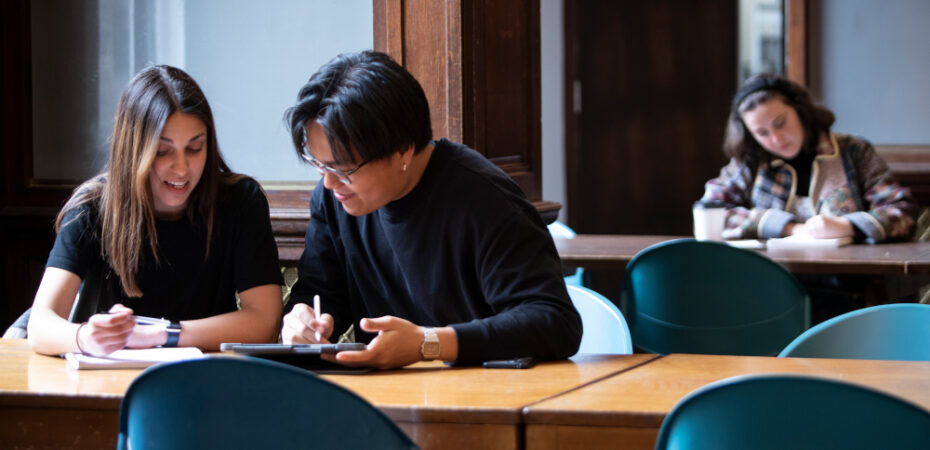
In the second blog post on the topic of international student transitions, Hannah Jones and Shirley Tian reflect on the pedagogical practices that can support international student transitions. In Part 1, Hannah and Shirley explain who they are, how the collaboration came about, and answer two questions on the topic: ‘What is transition and why is the topic of international student transition critical?’, and ‘What are the biggest challenges international students face in adjusting to a new environment?’. Hannah is Director of English Language Education at the Centre for Open Learning, and Shirley is an undergraduate student in History and Politics.
Hannah: Firstly, I do think the diversity in our classrooms can be an incredible opportunity for educators, and sadly this isn’t always drawn on from what I’m told by students. I am reminded of a comment from a postgraduate taught student, who told me he was in seminar with students from over thirty countries, and he was disappointed when the seminar did not create opportunities for sharing perspectives or information from these countries. So, I think part of what helps is just practices that draw on and value the different voices of our students.
However, we also know that in our institution our international classrooms aren’t always diverse, and in these circumstances, issues around interaction and silence can come to the fore. Interaction is a fundamental way in which we explore and learn (Dippold & Heron, 2021), but, culturally, silence can be a form of legitimate participation. Promoting interaction may require ‘scaffolding’, e.g. asking students to share questions in pairs before asking in front of the whole class and there needs to be space for educators to openly share the rationale for interactive classroom work.
Again, I would come back to language. Once students enroll, with their required IELTS scores, it’s assumed language should disappear as an issue. But it doesn’t, and we could do more to make language visible in disciplinary learning. Bond (2020) reports on practical ideas for this, e.g. labelling lab equipment in English – there are many names for different types of microscopes and none of them are likely to appear in an IELTS exam!
Finally, I would emphasise the idea of transition as ‘becoming’ that I highlighted in our first blog post (Gale and Parker, 2012). A really important part of this is seeing students as partners in transition and using inclusive, collaborative learning experiences to co-construct understanding and knowledge and value the voices of all students.
Shirley: Seconding Hannah’s points, I think it’s important to first acknowledge that for many international students, English is not their first language and, even for native speakers, mastering academic language is challenging. Adjusting to speaking and writing in an academic voice takes time, especially when students are translating ideas between languages. That’s why inclusive teaching should recognise silent observation and active listening as valid forms of participation, particularly for students from educational backgrounds where speaking up isn’t the norm.
Inclusive classrooms also avoid jargon, abbreviations, and assumptions about shared academic knowledge. This benefits all students, not just international ones, by reducing the likelihood of confusion, embarrassment, or self-doubt.
From auditing postgraduate seminars at Moray House, I’ve seen low-stakes, collaborative activities used effectively to support participation. Examples include mind mapping, small group discussions, and encouraging responses that reflect diverse cultural perspectives. These subtle shifts—like avoiding solo presentations or swapping group work outputs—can create space for students to engage meaningfully without the pressure of public speaking, making participation more accessible and affirming for everyone.
How can the the University support international student transitions?
Hannah: There are many examples of students and staff working together, e.g. the SLICCs and the Student Partnership Agreement-funded projects, but we could do more to see students as partners in an ongoing and sometimes messy transition experience and to co-construct that experience with our students. I also think we could do more to make the role of language visible and to value language learning as an ongoing element of disciplinary learning, rather than seeing it as a remedial stage that needs to conclude before the ‘real’ learning takes place.
Shirley: While there are positive efforts in place to support international students, I believe universities can do more—especially during the early transition period. Support should not be a one-way process where international students are treated as passive recipients. Too often, resources are concentrated in welcome week and then it fades, even though adjustment is ongoing. A more sustained, embedded approach is needed—one that actively integrates international student voices into classroom design, peer mentoring, and academic support throughout the year.
Initiatives like SACHA (Students As Change Agents), for example, offer a great model. They allow students from diverse backgrounds and disciplines to gain practical experience while also building confidence in academic communication and collaboration. Creating more spaces like this—where international students can co-create, contribute, and lead—fosters a deeper sense of belonging. Genuine student-staff collaboration, through focus groups, peer panels, or co-designed projects, helps shape support systems that are actually reflective of student needs. More than just improving services, this signals that international students are valued not as guests, but as active, vital members of the university community, something that’s essential for building a truly international campus culture.
Summary
We enjoyed this conversation and the process of writing together, which in fact embodies some of the partnership principles that we drew on in our conversation. In summary, through our reflections on international transitions, we have highlighted the need for an inclusive approach that values international students’ perspectives, the need for us to see transitions as an ongoing process, and the need to value and make visible the role of language in learning. We hope you have enjoyed reading it and hopefully this will inspire more student-staff collaboration initiatives in the future.
Read Perspectives on international student transitions: Part 1
References
Bond, B. (2020) ‘Making Language Visible in the University: English for Academic Purposes and Internationalisation’. [Online]. Blue Ridge Summit, PA: Multilingual Matters.
Dippold, D. & Heron, M. (eds.) (2021) Meaningful teaching interaction at the internationalised university moving from research to impact. Abingdon, Oxon ; Routledge.
Gale, T., & Parker, S. (2012). Navigating change: a typology of student transition in higher education. Studies in Higher Education, 39(5), 734–753. https://doi.org/10.1080/03075079.2012.721351
Lillis, Theresa et al. Working with Academic Literacies : Case Studies Towards Transformative Practice. Place of publication not identified: WAC Clearinghouse, 2015. Print.
 Shirley Tian
Shirley Tian
Shirley Tian is studying (MA) History and Politics at the University of Edinburgh, and is an Undergraduate Student Ambassador at the University. Shirley is passionate about international educational development and improvement in the student community,
 Hannah Jones
Hannah Jones
Hannah Jones is Director of English Language Education at the The Centre for Open Learning, University of Edinburgh. She is a highly committed English for Academic Purposes practitioner with a genuine passion for leadership. Her particular interests are focused on the development of academic literacies for all students, as well as the promotion of sustainable communities of EAP practice within higher education contexts.


